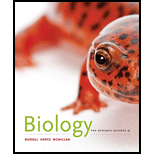
Introduction:
A zygote is a single-celled eukaryotic cell that is formed as the result of fertilization between two gametes. It undergoes mitosis to form an embryo that further develops into a multi-celled eukaryotic organism. The division of cells in the early embryonic stage is known as cleavage.
Answer to Problem 1TYK
Correct answer:
The major contributors to the cleavage development of zygotes are the egg nucleus and the yolk.
Explanation of Solution
Justification/explanation for the correct answer:
Option (d) states that the egg nucleus and the yolk are the major contributors to the cleavage patterns. The cleavage of the embryo occurs depending upon the amount of egg yolk present in the blastula (embryo after cleavage division is known as blastula). These cleavages can be holoblastic (total cleavage) or meroblastic cleavage (partial cleavage) that depends upon the amount of yolk present in the egg and the positioning of the nucleus in the egg. Hence, option (d) is correct.
The explanation for the incorrect answer:
Option (a) is given as sperm and egg cytoplasm. The cytoplasm is not the major contributing factor to the cleavage as the cleavage is mainly classified on the basis of the amount of yolk that is present in the egg. So, it is an incorrect option.
Option (b) is given as sperm and egg chromosomes. The chromosomes have nothing to do with the cleavage patterns. The chromosomes of the sperm and the egg consist of the genetic makeup of the embryo. So, it is an incorrect option.
Option (c) is given as ribosomes and mitochondria. These have an important role in the translation (expression of genetic material or formation of proteins) process and not in the cleavage divisions. So, it is an incorrect option.
Option (e) is given as pigments. Pigments can only be present after the genetic material expresses itself. The yolk and the egg nucleus contribute to the cleavage patterns of a zygote. So, it is an incorrect option.
Hence, options (a), (b), (c), and (e) are incorrect.
Therefore, it can be concluded that the cleavage patterns help in the organization and the development of different regions of the embryo or the blastula and turn it into a specialized region for the functioning of an organism. This depends on the amount of yolk present and the positioning of the nucleus in an egg and are thus, classified accordingly.
Want to see more full solutions like this?
Chapter 50 Solutions
Biology: The Dynamic Science (MindTap Course List)
- Can you described the image? Can you explain the question as well their answer and how to get to an answer to an problem like this?arrow_forwardglg 112 mid unit assignment Identifying melting processesarrow_forwardGive only the mode of inheritance consistent with all three pedigrees and only two reasons that support this, nothing more, (it shouldn't take too long)arrow_forward
- Oarrow_forwardDescribe the principle of homeostasis.arrow_forwardExplain how the hormones of the glands listed below travel around the body to target organs and tissues : Pituitary gland Hypothalamus Thyroid Parathyroid Adrenal Pineal Pancreas(islets of langerhans) Gonads (testes and ovaries) Placentaarrow_forward
- What are the functions of the hormones produced in the glands listed below: Pituitary gland Hypothalamus Thyroid Parathyroid Adrenal Pineal Pancreas(islets of langerhans) Gonads (testes and ovaries) Placentaarrow_forwardDescribe the hormones produced in the glands listed below: Pituitary gland Hypothalamus Thyroid Parathyroid Adrenal Pineal Pancreas(islets of langerhans) Gonads (testes and ovaries) Placentaarrow_forwardPlease help me calculate drug dosage from the following information: Patient weight: 35 pounds, so 15.9 kilograms (got this by dividing 35 pounds by 2.2 kilograms) Drug dose: 0.05mg/kg Drug concentration: 2mg/mLarrow_forward
- A 25-year-old woman presents to the emergency department with a 2-day history of fever, chills, severe headache, and confusion. She recently returned from a trip to sub-Saharan Africa, where she did not take malaria prophylaxis. On examination, she is febrile (39.8°C/103.6°F) and hypotensive. Laboratory studies reveal hemoglobin of 8.0 g/dL, platelet count of 50,000/μL, and evidence of hemoglobinuria. A peripheral blood smear shows ring forms and banana-shaped gametocytes. Which of the following Plasmodium species is most likely responsible for her severe symptoms? A. Plasmodium vivax B. Plasmodium ovale C. Plasmodium malariae D. Plasmodium falciparumarrow_forwardStandard Concentration (caffeine) mg/L Absorbance Reading 10 0.322 20 0.697 40 1.535 60 2.520 80 3.100arrow_forwardPlease draw in the missing answer, thank youarrow_forward
 Biology (MindTap Course List)BiologyISBN:9781337392938Author:Eldra Solomon, Charles Martin, Diana W. Martin, Linda R. BergPublisher:Cengage Learning
Biology (MindTap Course List)BiologyISBN:9781337392938Author:Eldra Solomon, Charles Martin, Diana W. Martin, Linda R. BergPublisher:Cengage Learning
 Human Biology (MindTap Course List)BiologyISBN:9781305112100Author:Cecie Starr, Beverly McMillanPublisher:Cengage Learning
Human Biology (MindTap Course List)BiologyISBN:9781305112100Author:Cecie Starr, Beverly McMillanPublisher:Cengage Learning Concepts of BiologyBiologyISBN:9781938168116Author:Samantha Fowler, Rebecca Roush, James WisePublisher:OpenStax College
Concepts of BiologyBiologyISBN:9781938168116Author:Samantha Fowler, Rebecca Roush, James WisePublisher:OpenStax College Biology: The Dynamic Science (MindTap Course List)BiologyISBN:9781305389892Author:Peter J. Russell, Paul E. Hertz, Beverly McMillanPublisher:Cengage Learning
Biology: The Dynamic Science (MindTap Course List)BiologyISBN:9781305389892Author:Peter J. Russell, Paul E. Hertz, Beverly McMillanPublisher:Cengage Learning Human Heredity: Principles and Issues (MindTap Co...BiologyISBN:9781305251052Author:Michael CummingsPublisher:Cengage Learning
Human Heredity: Principles and Issues (MindTap Co...BiologyISBN:9781305251052Author:Michael CummingsPublisher:Cengage Learning





